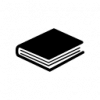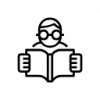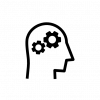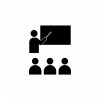- As Associate Dean (Education) in Medicine since 2016 and Senior Vice Dean (Education) since 2018, I have led UNSW Medicine's Blended Learning Project (funded by a UNSW SEF2 Learning and Teaching grant) and Medicine’s involvement in UNSW’s Inspired Learning Initiative.
- In 2015, I led the development of a generic instrument (Perceived Utility of Learning Technologies Scale) to evaluate online learning resources, which is available for use at UNSW and has been adopted for use by the BEST Network.
- In 2016, I led the development and analysis of a Faculty-wide survey of engagement with online and blended learning, which has informed the direction of the project.
- As a Fellow of the UNSW Scientia Education Academy since 2016, I have led the Academy's SEIF grant-funded project to identify the dimensions of effective teaching practice and to subsequently develop an ePortfolio for use by academic staff at UNSW.
- In 2017, I gave a Scientia Education Academy lecture titled: 'The Scientia Education Experience: Roles of Assessment, Feedback (and Humour)', and have led a number of Connections seminars for UNSW staff, ranging from Standards-Based Assessment to use of active learning tools in Lecture Recordings+.
- As Head of Department in Pathology from 2005-2016, I led a culture of excellence in education. I mentored, encouraged and inspired junior academic staff to: undertake professional development in learning and teaching; become involved in curriculum design; be innovative in their approach to teaching; and engage in the scholarship of learning and teaching.
- I encourage and support junior members of staff in applications for teaching awards and promotion, providing substantial advice and feedback on their applications.
- I have also fostered the next generation of potential academics by giving senior medical students and PhD candidates opportunities to undertake casual teaching in the Medicine program, working with them and supporting their development.
- Under my stewardship, four members of the Department have received national teaching awards.
- As Director of Learning and Teaching Development, School of Medical Sciences since 2011, I engage academic staff in educational innovations and the scholarship of teaching and learning. I am currently leading a review of all courses within SoMS to align with the Scientia Education Experience. I also lead the School's VCATE Committee, providing feedback to staff applying for University and national teaching awards.
- My leadership has resulted in widespread staff involvement in eLearning innovations such as online formative assessments, adaptive tutorials and online concept maps. This has led to peer-reviewed publications by academic staff outside my discipline, who were previously not research active.
- This work, together with feedback I provided to academic staff in my role as Chair of the SoMS VCATE Committee, has contributed to 10 successful VCATE applications over the past 6 years.
- I have made, and continue to make, critical contributions to the development, implementation and evaluation of the Medicine program across all Phases via involvement in a range of Faculty and cross-Faculty committees.
- As a member of the Faculty Assessment Development and Evaluation Group and Chair of the Phase 3 Biomedical Sciences Working Party, both from their inception, as well as the Faculty Academic Committee, I Chair assessment subcommittees for Phases 1 and 2 of the Medicine program (through which I oversee all non-clinical assessments). Through this work I have contributed to the development of the program’s graduate attributes. I have also designed assessment strategies to evaluate students’ development of those attributes and to provide timely, effective feedback.
- I have played a prominent role in UNSW Medicine's Blended Learning Project (funded by a UNSW SEF2 Learning and Teaching grant) from the outset, and in recognition of my expertise, have been invited to lead the project in 2016.
- In 2015, I led the development of a generic instrument to evaluate online learning resources, which is available for use at UNSW and has been adopted for use by the BEST network.
- In 2016, I led the development and analysis of a Faculty-wide survey of engagement with online and blended learning, which has informed the direction of the project.
- In 2015, I obtained a competitive UNSW Learning and Teaching Fellowship. This aligns closely with UNSW Medicine’s Standards-Based Assessment (SBA) project, in which I also have a leadership role.
- Through my Fellowship, I led a multidisciplinary team of colleagues to form a community of practice, which resulted in the development of content and performance standards in Biomedical Sciences. I subsequently implemented innovative discipline-based reports which enable students in the Medicine program to monitor their progress in learning.
- As UNSW leader of the Biomedical Education and Skills Training (BEST) Network since 2015, I have driven continued expansion of the network, which now engages more than 1,900 academics and more than 5,000 students in a learning community involving 12 institutions nationally and internationally.
- BEST Network resources, including adaptive tutorials, virtual laboratories and the Slice database containing more than 20,000 biomedical images, have become an indispensable component of education practice in both Medicine and Science faculties.
- BEST engages learners as partners in the development and continued improvement of resources, through casual employment as well as by integration of resource development within course curricula.
- As Curator of the Museum of Human Disease since 2002, I have guided the expansion of the Museum’s educational role beyond Medicine and Science students to high school students and community groups state-wide.
- The Museum annually hosts more than 10,000 senior high school students as well as 1,000 members of the general public, and is the Faculty of Medicine’s flagship outreach venue. The Museum continues to be heavily used by medical students. Their interest is reflected in the numbers who volunteer to guide groups of Museum visitors.
Educational leadership roles




